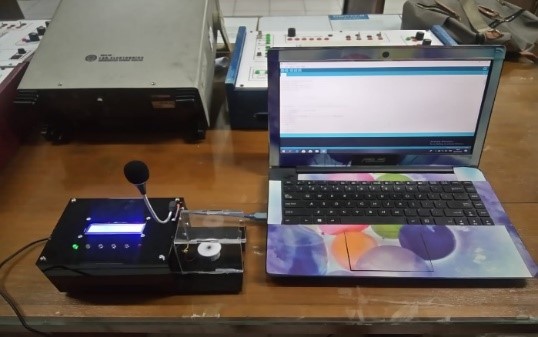DC Motor Speed Regulation Using Speech Recognition
DOI:
https://doi.org/10.12928/biste.v3i1.1751Keywords:
Pengaturan kecepatan, Arduino Uno, Motor DC, Speech RecognitionAbstract
One of the uses of this sound technology is controlling the speed of a DC motor. Sound in the form of a spectrum signal can be converted to digital. Digital signals can be used as a microcontroller input to adjust the speed of a DC motor using the PWM (pulse width modulation) method. The design of the tool uses the V3 voice recognition module to convert the voice into digital. A microcontroller as a voice data processor by changing the input voltage to a DC motor. Voice command to set DC motor speed. Based on the results of tests carried out in good environmental conditions, 90% of voice commands can be recognized. Meanwhile, in bad environmental conditions by 50%. Manual measurement is done by entering the input voltage from 1 volt to 10 volts. The results of the comparison show that the speed is almost the same, namely 2727 rpm for manual calculation and 2915 rpm for the whole tool. This difference occurs because the test when manually inputting the tension is not very accurate. It can be concluded that the tool is working properly and as desired. If the environmental conditions are bad only 50% can be recognized from 30 voice commands, then there is a difference in voice intonation during the training process.References
R. Birdanyansyah, N. Sudjarwanto, O Zebua, "Pengendalian Kecepatan Motor DC Menggunakan Suara Berbasis Mikrokontroler Arduino," ELECTRICIAN, Vol 9, no 2, pp 1-12, 2015. https://doi.org/10.23960/elc.v9n2.168
M. Rusdi, A. Yani, "Sistem Kendali Peralatan Electronik Melalui Media Bluetooth Menggunakan Voice Recognition," J of Electrical Technology, Vol 3, no 1, pp 1-7, 2018. https://doi.org/10.30743/infotekjar.v3i2.905
A. Imario, D. Sudiharto, E. Apriyanto, "Uji Validasi Suara Berbasis Pengenalan Suara (Voice Recognition) Menggunakan Easy VR 3.0," Prosiding SNATIF, 2017. https://core.ac.uk/download/pdf/327101698.pdf
A. Dani, A.Andriyansyah, D. Hermawan, "Perancangan Aplikasi Voice Command Recognition Berbasis android dan arduino Uno," J. Tek. Elektro, Vol 7, no. 1, pp 1-9, 2016. https://doi.org/10.22441/jte.v7i1.811
Baharuddin, R. Sajdad, M. Tola, "Sistem Kendali Kecepatan Motor DC berbasis PWM (Pulse width Modulation)," Jurnal Teknologi Terpadu, Vol 4, no 1, pp 1-12, 2012. http://pasca.unhas.ac.id/jurnal/files/0ffe9af51c51e48ca3e5da4480a76497.pdf
Royan, A Luqman, " Aplikasi motor DC-Shunt Untuk Laboratory Shaker Menggunakan Metode PWM (Pulse Width Modulation) Berbasis Mikrokontroler Atmega 32," Media Elektrika, Vol 8, no 1, pp 1-19, 2015. https://doi.org/10.26714/me.8.1.2015.%25p
Muchlas, Sunardi, T Antoro, " Pengendalian Kecepatan Motor DC Dengan Metode Look Up Table Berbasis Mikrokontroler AT89C51," TELKOMNIKA, Vol 4, no. 1, pp 1-10, 2006. https://doi.org/10.12928/telkomnika.v4i1.1238
D. Setiawan, "Sistem Kontrol Motor DC Menggunakan PWM Arduino Berbasis Arduino Sistem," Jurnal Sains, teknologi dan industri, Vol 15, no 1, pp 33-34, 2017. http://dx.doi.org/10.24014/sitekin.v15i1.4131
D. Handoko, P. Kasih, "Voice Recognition untuk Sistem Keamanan PC Menggunakan Metode MFCC dan DTW," Generation Journal, Vol 2, no. 1, pp1-12, 2018. https://doi.org/10.29407/gj.v2i1.12058
J.Ardi, Nurussa'adah, M. Rif'ain, "Implementasi Sistem Voice Recognition Pada Robot Pemindah Object sebagai Sistem Navigasi," Jurnal Mahasiswa TEUB, Vol 2, no. 1pp 1-6, 2014. http://elektro.studentjournal.ub.ac.id/index.php/teub/article/view/192

Downloads
Published
How to Cite
Issue
Section
License
Copyright (c) 2021 Firda Andriyan Andriyan, Wahyu Sapto Aji

This work is licensed under a Creative Commons Attribution-ShareAlike 4.0 International License.
Authors who publish with this journal agree to the following terms:
- Authors retain copyright and grant the journal right of first publication with the work simultaneously licensed under a Creative Commons Attribution License that allows others to share the work with an acknowledgment of the work's authorship and initial publication in this journal.
- Authors are able to enter into separate, additional contractual arrangements for the non-exclusive distribution of the journal's published version of the work (e.g., post it to an institutional repository or publish it in a book), with an acknowledgment of its initial publication in this journal.
- Authors are permitted and encouraged to post their work online (e.g., in institutional repositories or on their website) prior to and during the submission process, as it can lead to productive exchanges, as well as earlier and greater citation of published work (See The Effect of Open Access).
This journal is licensed under a Creative Commons Attribution-ShareAlike 4.0 International License.


